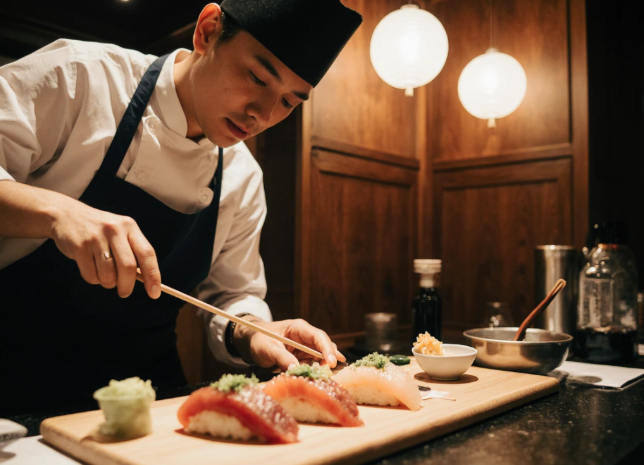Pontocho sushi represents the full spectrum of Japanese sushi-making philosophy, from strictly traditional Edomae techniques to bold contemporary fusion. This narrow alley in Kyoto offers both purists and adventurous eaters a chance to experience how centuries-old methods coexist with modern innovations in sushi craftsmanship.
More about Pontocho:
- Pontocho Park Guided Tours
- The Complete Guide to Pontocho: Kyoto’s Most Atmospheric Alley
- Pontocho Restaurants: Complete Dining Guide
How Pontocho Became Kyoto’s Sushi Corridor
Pontocho transformed from a modest geisha entertainment district in the 1670s into one of Kyoto’s premier dining destinations. The alley, originally built to serve tea houses and traditional performances, shifted focus to culinary excellence in the mid-20th century. By the 1980s, rising disposable incomes and increased tourism pushed restaurateurs to diversify beyond kaiseki. Sushi chefs, traditionally concentrated in Tokyo and Osaka, began opening intimate establishments in Pontocho’s compact storefronts.
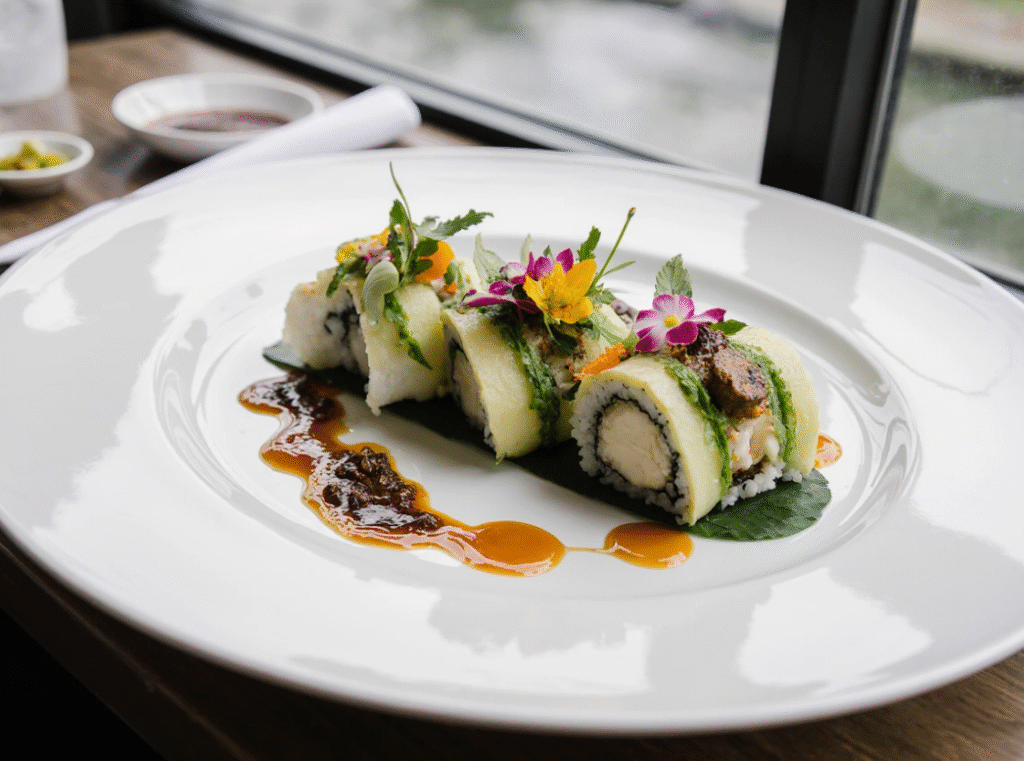
Modern Fusion Sushi at Best Sushi Restaurants in Pontocho, Kyoto
The narrow street could have remained exclusively traditional. Instead, a younger generation of chefs in the 2000s introduced fusion concepts while maintaining respect for classical techniques. Today, you’ll find century-old sushi counters operating three doors down from venues serving truffle-topped toro.
What Makes Edomae Sushi Kyoto Style Different
Edomae sushi follows strict preparation methods developed in Tokyo during the 1800s. Fish is aged, cured, or marinated rather than served immediately after cutting. Rice is seasoned with red vinegar instead of white, creating a sharper flavor profile. This technique emerged from necessity—Tokyo Bay fishermen needed preservation methods before refrigeration existed.
According to the Japan National Tourism Organization, Edomae techniques remain the gold standard for traditional sushi preparation. Masters cure kohada (gizzard shad) for precisely 40 minutes in vinegar. Timing matters. Anything less tastes raw. Anything more turns mushy.
Modern nigiri specialists in Pontocho maintain these exact timings. At traditional counters, you won’t see salmon. You won’t see fusion rolls. You will see anago brushed with nikiri sauce made from a tare passed down through three generations.
The Core Difference: Fish Treatment and Rice
Traditional Edomae Approach:
- Fish: Aged 3-7 days depending on species
- Rice: Red vinegar (akazu), served at body temperature
- Preparation: Salt-curing, kombu-aging, soy marinating
- Presentation: Minimal garnish, fish and rice only
Modern Fusion Approach:
- Fish: Fresh, often same-day catch
- Rice: White vinegar or seasoned varieties
- Preparation: Torching, truffle oils, Western ingredients
- Presentation: Elaborate plating, multiple garnishes
The price point? Traditional omakase at Pontocho sushi bars starts at ¥15,000 ($100). Fusion options range from ¥8,000-¥20,000 depending on ingredient sourcing.
Three Common Mistakes When Ordering Sushi in Pontocho
Choosing a venue based only on photos
Travelers scroll Instagram, see beautiful plating, and book the first available spot. The establishment looks modern and approachable.
- Why they do it: Social media algorithms push visually striking content. Contemporary venues photograph better than traditional spots. The torched fish and colorful garnishes look more impressive than simple nigiri.
- Price of the error: You wanted traditional Edomae but ended up at a fusion spot. The chef uses blowtorches and truffle oil. Your ¥18,000 meal tastes good but nothing like what you researched. You’ve spent $120 and a prime dinner slot on the wrong style. Time lost: one evening. Money lost: the meal cost plus the mental frustration of missing your goal. Better approach: Check venue websites or Japan-based review sites like Tabelog to verify the style before booking based on appearance alone.
Sitting at a table instead of the counter
Tables seem comfortable. You can talk with your group without bothering anyone. The seating feels less intimidating for first-timers at Pontocho sushi counters.
- Why they do it: Counter seating feels exposed. Many travelers worry about making etiquette mistakes in front of the itamae (sushi chef). Tables offer a buffer zone and privacy.
- Price of the error: The entire point of high-end sushi is the chef’s performance and real-time explanation. At a table, you’re served by waitstaff who don’t speak much English. You miss timing cues, preparation details, and the theatrical element. The ¥20,000 experience becomes just expensive fish on rice. You paid $135 for half the actual experience.
Ordering a la carte in an omakase establishment
The menu shows individual pieces. You think you’ll save money by choosing only what you recognize. Salmon and tuna feel safe. Unfamiliar fish names create anxiety.
- Why they do it: Omakase means surrendering control. For travelers who’ve had bad experiences with unfamiliar foods, this feels risky. Ordering familiar items seems like smart budget management.
- Price of the error: The chef designed omakase to showcase seasonal progression and flavor balance. Ordering California roll and salmon signals you don’t understand the format. The chef loses enthusiasm. You miss aged fish you’d actually enjoy because you stuck to safe choices. You paid ¥12,000 for a mediocre experience when ¥15,000 would have given you something extraordinary. Money lost: the cost difference is minimal, but the quality gap is massive.
“Request a seat directly in front of the cutting board, not at the ends. End seats get served last and miss the chef’s preparation show. The center three spots are prime. If booking through your hotel concierge, specifically say ‘kaunta no mannaka onegaishimasu’ (counter middle, please). This matters more than which night you visit.”
Best Sushi Restaurants in Pontocho: Where Tradition Lives
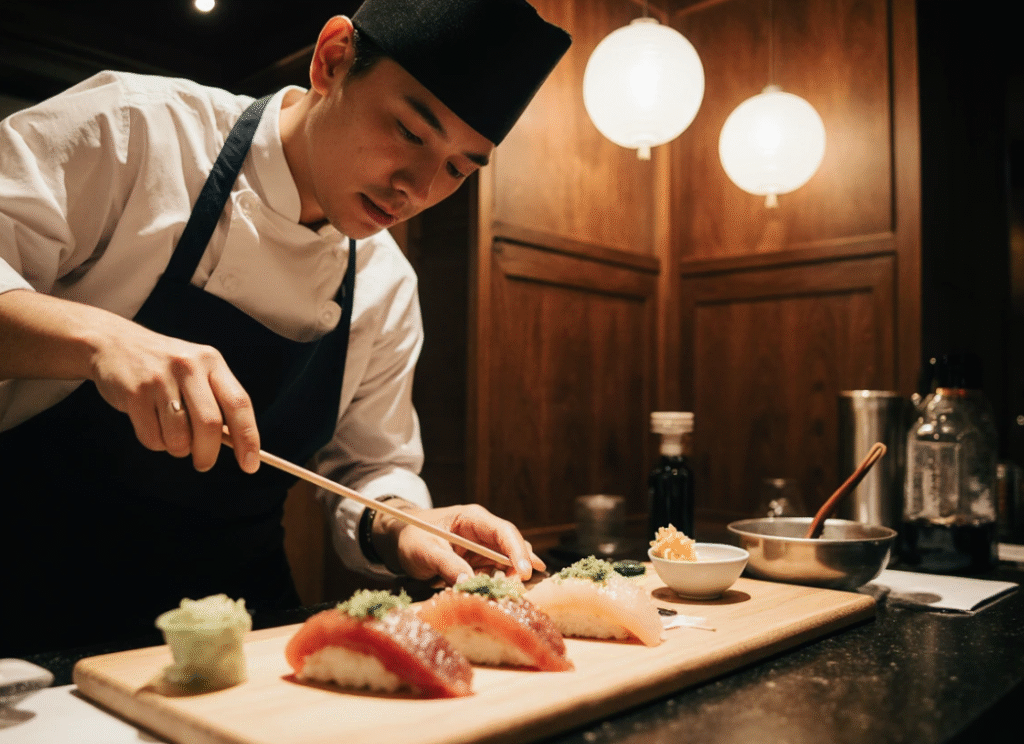
Traditional Edomae Sushi Experience at Pontocho Sushi Restaurant in Kyoto
Four to six establishments in Pontocho maintain orthodox Edomae methods without modification. These spots source from Tokyo’s Toyosu Market (which replaced Tsukiji) or directly from Kyoto’s Nishiki Market vendors who supply aged fish.
Expect these characteristics when dining at traditional Pontocho sushi venues:
- No printed menu
- No substitutions
- Sake recommendations before you ask
- Rice formed by hand pressure alone, never molds
- Each piece designed to be eaten within 3 seconds of placement
The chef watches to ensure you eat immediately while the rice is at optimal temperature—36.5°C, matching body heat. This isn’t micromanagement. It’s precision timing. Rice temperature drops rapidly, changing texture and flavor.
Count on 18-22 pieces over 90 minutes. The progression starts light (white fish), moves through medium-flavored fish, peaks with fatty tuna, then finishes with tamago. You’ll see fish you’ve never heard of: sayori, shako, kuruma ebi prepared three different ways.
No photography policies exist at the strictest establishments. The chef views camera time as disruption to eating rhythm. Some allow one photo at the end, but constant phone use will earn disapproving silence.
The Fusion Side: Modern Sushi Interpretation in Pontocho
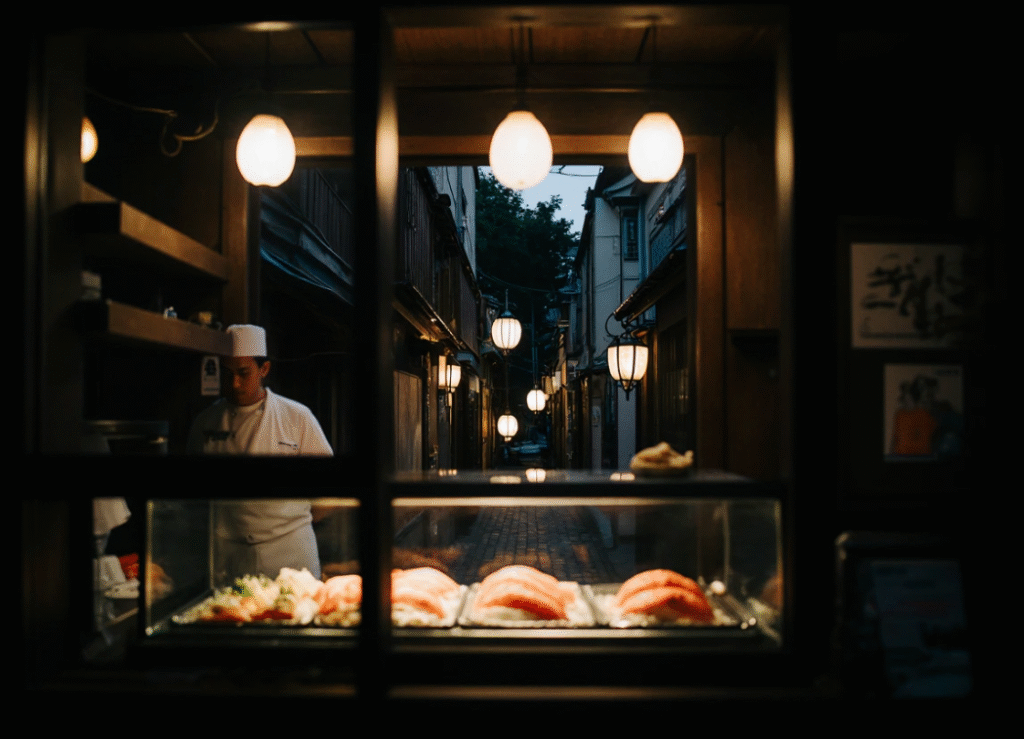
Authentic Sushi Bar with Pontocho Alley View – Best Sushi in Kyoto
Eight to ten venues blend Western ingredients with Japanese technique. These aren’t California roll factories. Think Edomae precision applied to non-traditional ingredients.
You’ll encounter at modern Pontocho sushi spots:
- A5 wagyu nigiri with crispy garlic chips
- Sea urchin topped with caviar and edible gold
- Toro drizzled with white truffle oil
- Foie gras replacing traditional fatty fish
The rice base remains Japanese—short grain, vinegared, hand-formed—but flavor profiles break rules. Some purists call this disrespectful. Others see evolution. The chefs typically trained in traditional methods for 10-15 years before experimenting. They’re not ignorant of rules; they’re choosing which ones to break.
Contemporary sushi establishments accommodate dietary restrictions. Want vegetarian options? They’ll create something legitimate, not just cucumber rolls. Gluten-free tamari replaces standard soy sauce without asking.
Behind the Scenes: Three Facts Most Guides Miss

- Rice determines everything in Pontocho sushi preparation. The grain variety (Koshihikari or Sasanishiki), water source, cooking method, and vinegar ratio matter more than fish quality. A master spends three years learning rice alone before touching fish. Traditional shops use water from specific wells that maintain mineral content ideal for rice texture. The Kyoto Cuisine Culture Association documents how local water chemistry shapes regional cooking styles.
- Real wasabi costs ¥8,000 per kilogram. The green paste you’re used to is horseradish and food coloring. Fresh-grated wasabi rhizome delivers completely different flavor—sweet, complex, with heat that dissipates in seconds rather than lingering. It lasts about 15 minutes after grating. If your sushi arrives with wasabi already placed by the chef, don’t add more from the table. The chef calculated the exact amount for that specific fish. Adding extra is like telling a pianist their volume is wrong.
- Seasonal timing controls Pontocho menus entirely. June brings hamo (pike conger) from Kyoto’s rivers. August means aji (horse mackerel) from Wakasa Bay. December brings cold-water fish with higher fat content. If you visit in cherry blossom season expecting the same fish as autumn, you’ll get a completely different meal. There’s no year-round menu at legitimate establishments.
The Other Side: When Pontocho Sushi Disappoints
Budget travelers face harsh reality. Entry-level omakase starts at ¥15,000. A premium experience hits ¥30,000-¥40,000. For travelers planning ¥8,000 daily food budgets, a high-end sushi dinner consumes two days of meals. Choosing this experience means sacrificing other Kyoto activities or accommodations. Osaka’s standing sushi bars offer 90% of the quality for 40% of the price—if your budget is tight, consider day-tripping to Osaka instead.
The intimate setting backfires for large groups. Most establishments seat 8-12 people maximum. Groups of four or more struggle to find availability in Pontocho. If you’re traveling with kids who won’t eat unfamiliar fish, this destination doesn’t work. Children under 12 are discouraged or banned entirely at traditional counters. The reasoning: maintaining quiet atmosphere and preventing food waste when kids refuse dishes.
Strict omakase format removes control. You can’t skip courses. You can’t request extra pieces of your favorite. The chef decides everything. For travelers who need to avoid specific ingredients due to allergies or preferences, the format becomes stressful rather than enjoyable. Fusion venues offer more flexibility, but traditional spots view modifications as disrespectful.
Counter vs. Table: Making the Right Choice
The counter delivers the full sushi experience in Pontocho. You watch fish preparation, receive pieces seconds after assembly, and interact directly with the chef. Language barriers matter less because the chef demonstrates with gestures. You learn fish names, see knife techniques, understand why each piece is prepared differently.
Tables work for groups prioritizing conversation over education. You’ll still eat excellent sushi, but the performance element disappears. Service staff handle delivery. You lose the timing precision—pieces might sit 30 seconds before reaching your table. The rice cools. The texture changes.
First-timers should always choose counter seats at Pontocho sushi bars. The premium is minimal (sometimes no additional charge), but the experiential difference is enormous.
Practical Planning: Reservations and Timing for Pontocho Dining
Book 4-6 weeks ahead for the best sushi restaurants Pontocho offers. Fusion venues offer more flexibility—1-2 weeks usually works. Concierge services handle this better than online systems because they maintain relationships with establishments and understand how to communicate your preferences accurately. The reservation includes your seating time and expected duration. Arrive within 5 minutes of your slot. Japanese dining operates on strict schedules.
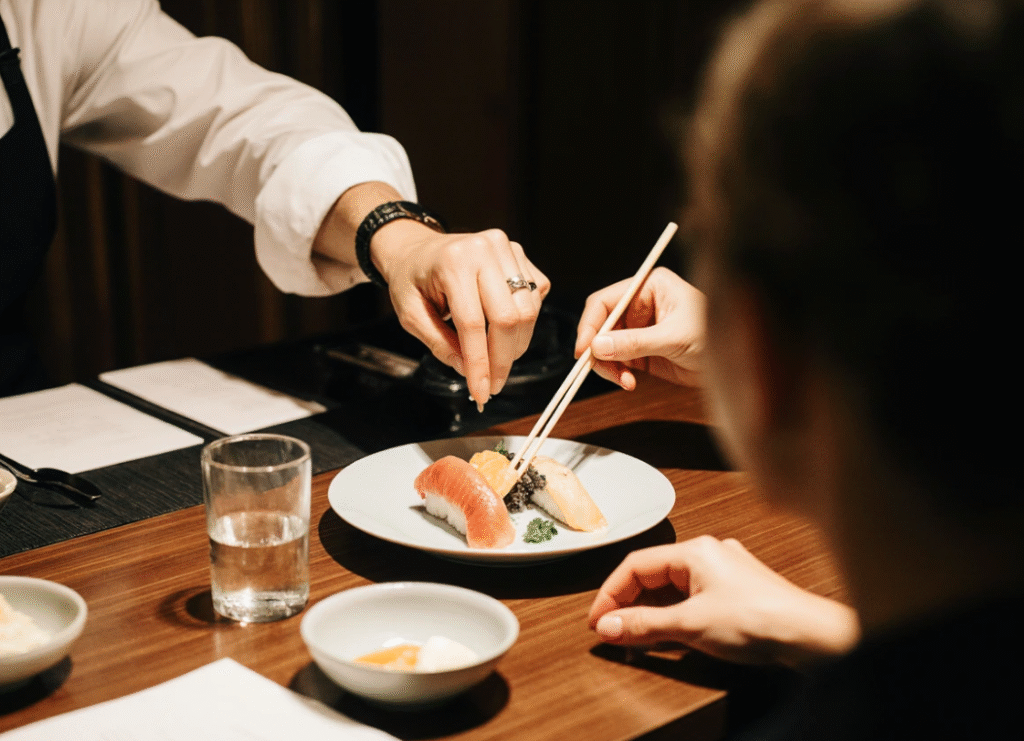
Premium Omakase Sushi Experience at Pontocho’s Best Sushi Restaurant in Kyoto
Best visiting times: November through February brings the highest quality fish to Pontocho. Water temperatures around Japan drop, increasing fat content in fish bodies. March-April cherry blossom season means peak tourism and lower availability. July-August heat affects fish quality at lower-end establishments, though top venues maintain cold chain integrity year-round.
Budget ¥15,000-¥25,000 per person for traditional omakase including one sake pairing. Fusion spots run ¥12,000-¥20,000. Add ¥3,000-¥5,000 for premium sake selections. These prices include tax but not service charge, which is typically built into the meal cost in Japan.
What to Expect at the Sushi Counter
The chef greets you, often in minimal English. At traditional Pontocho establishments, omakase begins immediately without menu discussion. Fusion venues might offer brief explanations of their approach or ask about preferences.
Pieces arrive one by one, roughly every 90 seconds. Pick up with your hands or chopsticks—both are acceptable at most Pontocho sushi counters. Dip fish-side into soy sauce, never rice-side (rice absorbs too much liquid and falls apart). Eat in one bite. Two bites suggest the portion is too large, insulting the chef’s judgment about proper serving size.
“Don’t mix wasabi into soy sauce. This dilutes both flavors and marks you as inexperienced. The chef already placed wasabi between fish and rice. Your job is to eat what’s presented without modification. If you genuinely want extra wasabi, ask directly: ‘Wasabi motto kudasai.’ The chef will add the right amount to the next piece.”
Don’t feel obligated to finish every grain of rice or drink all your tea. Leaving a small amount signals satisfaction. Cleaning your plate completely can suggest you’re still hungry and the portions were inadequate.
Making Your Choice: Traditional or Fusion?
Choose edomae sushi Kyoto style if you want historical authenticity and are comfortable with unfamiliar fish. Expect stronger flavors from aged and cured fish—think funkier, more complex, less clean-tasting than what you might be used to. This style rewards patience and openness to the chef’s vision. You surrender control but gain education in traditional sushi craft.
Choose fusion if you prefer familiar flavor profiles with Japanese precision. These establishments accommodate preferences and dietary needs more readily. The experience feels less formal and more accessible for first-time high-end sushi eaters. You maintain some control over ingredient selection without sacrificing technique quality.
Both styles can be exceptional in Pontocho. Neither is inherently superior. The question isn’t which is “better,” but which matches your expectations for this specific meal. Consider what you’ll remember in five years: the Instagram-worthy truffle toro, or the education in 200-year-old preservation techniques?
Your answer determines which Pontocho venue to book.
